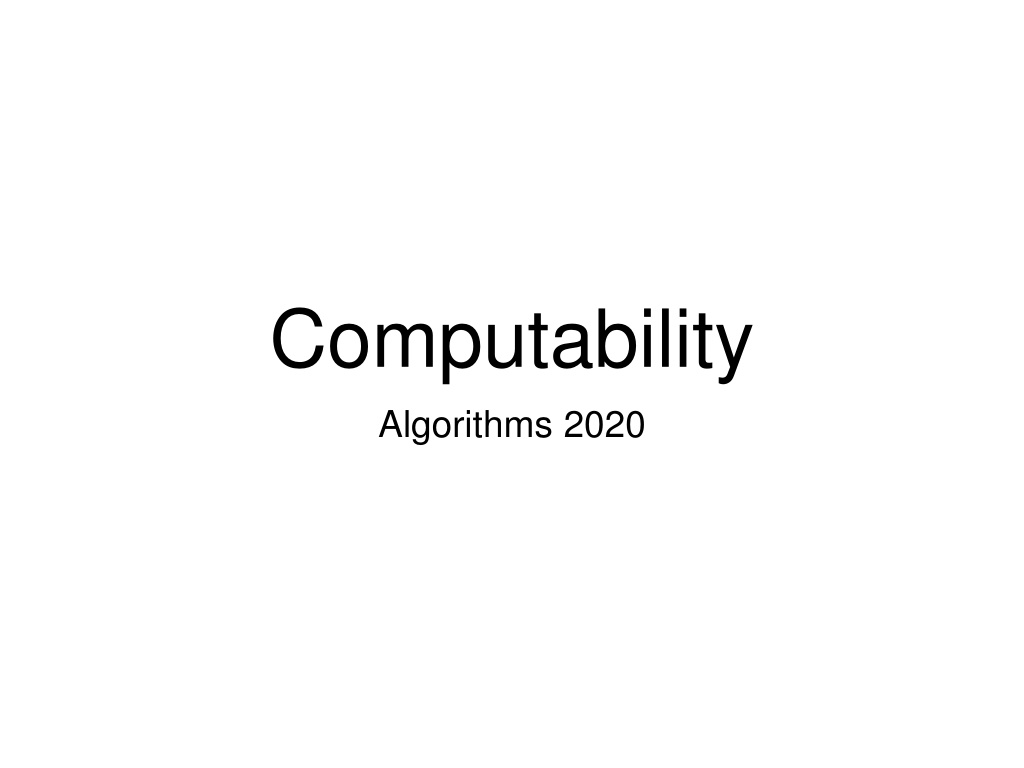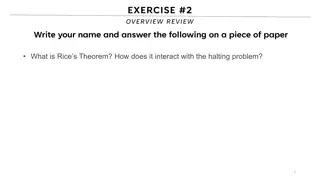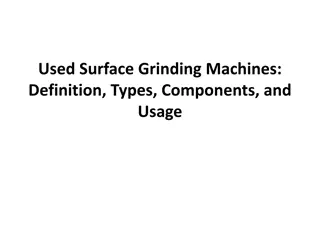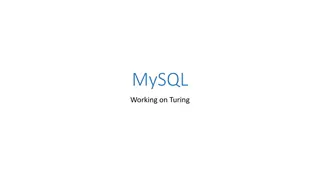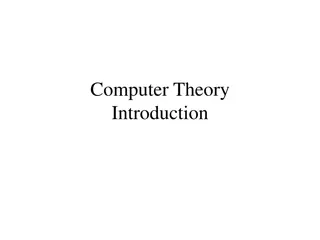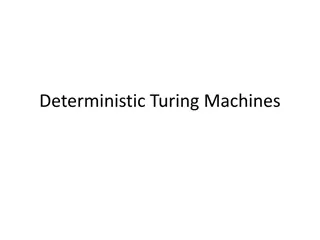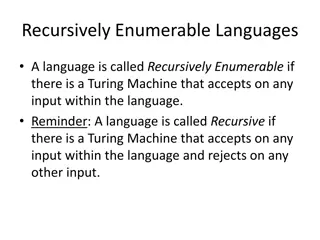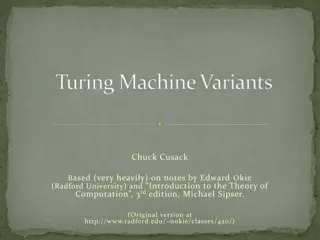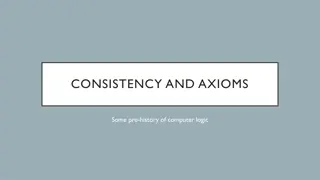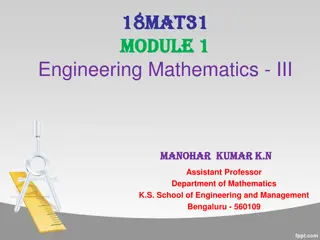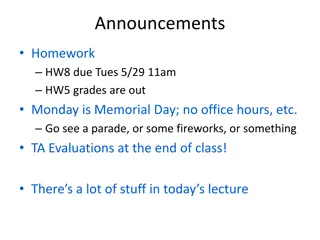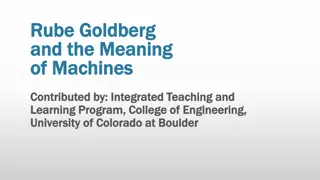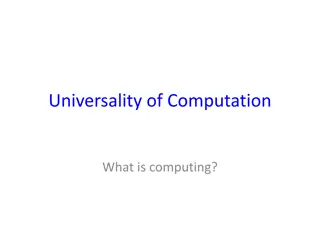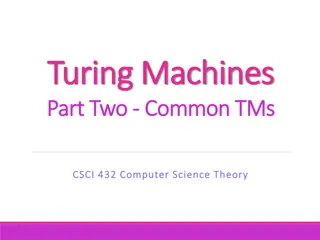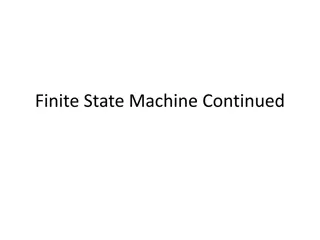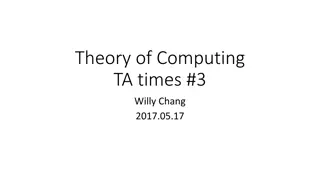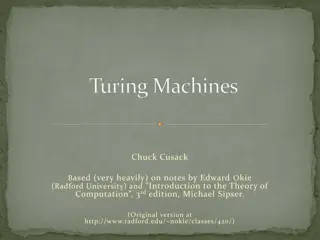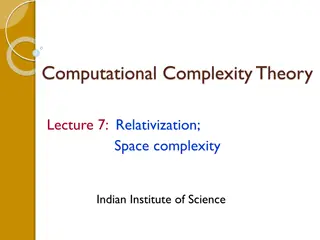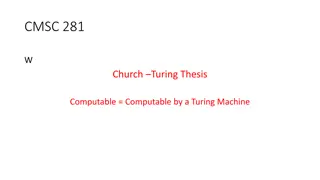Exploring Hilbert's Program and Turing Machines in Mathematics
Delve into Hilbert's Program and its impact on the understanding of mathematical truth, from attempts to resolve paradoxes to the concept of formalization of effective procedures. Understand the significance of Godel's incompleteness result in the context of algorithmic decision-making. Explore the Church-Turing Result and the equivalence between -calculus and Turing machines, shedding light on what is computable by both humans and computers.
- Hilberts Program
- Turing Machines
- Godels Incompleteness
- Algorithmic Decision-making
- Church-Turing Result
Download Presentation

Please find below an Image/Link to download the presentation.
The content on the website is provided AS IS for your information and personal use only. It may not be sold, licensed, or shared on other websites without obtaining consent from the author. Download presentation by click this link. If you encounter any issues during the download, it is possible that the publisher has removed the file from their server.
E N D
Presentation Transcript
Computability Algorithms 2020
Hilberts Program Grundlagenkrise in Mathematics (~ 1900): How to be sure that Mathematics is true Attempts suffer from paradoxes Example Na ve Set Theory: Russel s set of all sets that do not contain themselves as an element Answers to the Grundlagenkrise Intuitionism: Mathematics is a human activity, it does not discover universal truth Logicism: All mathematics derives from logic Formalism: Mathematics is a game with certain rules that conform to our thinking processes
Hilberts Program A formulation of all mathematics Completeness: Proof that all true mathematical statements can be proved in the formalism. Consistency: Proof that no contradiction can be obtained in the formalism of mathematics. Conservation: Proof that any result about "real objects" obtained using reasoning about "ideal objects" (such as uncountable sets) can be proved without using ideal objects. Decidability There is an algorithm for deciding the truth or falsity of any mathematical statement.
Hilberts Program Hilbert s program: Find an algorithm that can decide the truth or falsity of an arbitrary statement in first-order predicate calculus applied to integers G del s incompleteness result (1931) No such effective procedure can exist
Hilberts Program Formalization of effective procedure Each procedure should be described finitely Each procedure should consist of discrete steps, each of which can be carried out mechanically Number of proposals -calculus Turing machines (in different versions) RAM machines (computers with infinite memory)
Hilberts Program Church Turing Result: -calculus and Turing machines have the same computational power Church Hypothesis Turing machines are equivalent to our intuitive notion of a computer What is computable by a human is what is computable by a computer which is what is computable by a Turing machine
Turing Early career is as a Mathematical Logician Idea: What is computable Proposes the Turing machine as a simple example of what a Mathematician can calculate (without the brilliance) I.e.: A very simple formal way to compute Idea: If something is possible in that simple system then a human Mathematician can do it as well
Turing Entscheidungsproblem: Can every true statement in first order logic (with quantifiers) be derived in first order logic Answers a dream of Gottfried Leibniz: Build a machine that could manipulate symbols in order to determine the truth values of mathematical statements.
Turing Made it plausible that a Mathematician is not more powerful than the Turing calculus Proved limitations on what a Turing calculus can achieve Post thought that Turing s machine was too complicated and proposed a cleaner definition of the machine
Post-Turing Machine A Turing machine consists of An infinitely-long tape divided into squares that are initially blank (denoted by a symbol b ) A read-write head that can read and write symbols A control unit that consists of a state machine In a given state and when reading a given symbol: The machine goes to a new state The machine writes a new symbol The machine moves to the left or the right by one step.
Post-Turing Machines Turing machine input A string on the tape, with all other symbols being blanks. Turing machine output Turing machines can make decisions: By writing them on the tape By entering an accepting or a rejecting state These possibilities are actually equivalent http://morphett.info/turing/turing.html
Post-Turing Machines Turing machine programs: A program consists of a set of transition rules: Current state, Current Symbol > New State, New Symbol, Move Note: All Turing machine programs are finite
Post-Turing Machine Despite its simplicity, a Turing machine can imitate any computer (known today)
Post Turing Machine Turing machine programs consists of lines <curr. state> <curr. symb> <new symb> <dir> <new state>
Turing Machine Example Palindrome detector Accepts if the input binary string surrounded by blanks is a palindrome Algorithm: Find the left-most symbol, erase it, and remember it Go to the right until we are over a blank Move one to the left and check the symbol, erasing it Continue until A discrepancy is discovered Until no more symbols are left over
Turing Machine Example go to the left until we find a blank state0, 0, 0, left, state0 state0, 1, 1, left, state0 state0, b, b, right, state1 now we are at the beginning of the word we erase the symbol, but remember the symbol (through the state) and go right state1, 0, b, right, state_seen_zero state1, 1, b, right, state_seen_one
Turing Machine Example we go right until we hit a blank, then we go back one step to compare state_seen_zero, 0, 0, right, state_seen_zero state_seen_zero, 1, 1, right, state_seen_zero state_seen_zero, b, b, left, state0end state_seen_one, 0, 0, right, state_seen_one state_seen_one, 1, 1, right, state_seen_one state_seen_one, b, b, left, state1end
Turing Machine Example We are now over the last symbol If the symbol does not match, we go to the non- acceptance state If the symbol matches, we start moving left until we hit the blank that we created state0end, 1, b, stop, not_accepted state0end, 0, b, left, state_go_left state1end, 0, b, stop, not_accepted state1end, 1, b, left, state_go_left
Turing Machine Example We just go left until we hit the blank, at which point we go right and start over state_go_left, 0, 0, left, state_go_left state_go_left, 1, 1, left, state_go_left state_go_left, b, b, right, state1
Turing Machine Example When do we stop: If there are only blanks on the tape We are then in state1 and we encounter another blank state1, b, b, stop, accept
Turing Machine Example You can run this example at http://morphett.info/turing/
The Universal Turing Machine We can extend the model of the Turing machine E.g. we can have Turing machines with two tapes But we do not get anything more, Because we can emulate a Turing machine with two tapes with a Turing machine with one tape How? Even cells are for tape 0, odd cells are for tape 1, and a more complicated state machine
The Universal Turing Machine We can emulate a Turing machine with n tapes with a standard one This becomes a model for a RAM machine with n memory cells RAM machine stores program in some dedicated memory locations
The Universal Turing Machine We can also build a universal Turing machine Initially: a Turing machine program plus input, separated by blanks Machine then simulates the execution of a Turing machine Machine halts when the simulated Turing machine halts
The Universal Turing Machine A single machine that can emulate all possible Turing machines!!
Diagonalization Proofs Mathematical technique developed by Cantor Trick is applying something to itself Example: We can count all rational numbers Use the following scheme
Diagonalization Proofs Cantor: The real numbers in [0,1] are not countable Assume that they are: Let be an enumeration of real numbers Write the numbers as binary numbers, leave out the leading dot ?1,?2,?3,?4,?5,
Diagonalization Proofs Now define a new number defined by the enumeration itself ??= 1 ??,? The ith binary digit of t is the opposite of the ith digit of the ith number
Diagonalization Proofs If this would be an enumeration of all real numbers in [0,1], then t would appear in the enumeration Suppose it is the jth element Look at the jth digit of t ??,?= ??= 1 ??,? So, this is not possible Ergo: we cannot enumerate the numbers in [0,1]
Diagonalization Proofs This is a similar argument to Russell s paradox: X = The set of all set that do not have themselves as an element. Is ? ?
Diagonalization Proofs The universal Turing machine allows us to do the same type of self-application to show impossibilities
Impossibility Can everything (whatever that means) be computed Halting Problem: Will a program stop executing Answer: There is no algorithm that can decide whether a given program will stop executing Though most of the time, we can decide so easily
Proof: The Halting Problem is not-computable Assume that we have a program that can decide the halting problem Input: A program basically a long string An input Output: A decision the program will halt on that input or the program will not halt on that input
Proof: The Halting Problem is not-computable Assume that there is such a program def halting(program, input): #something really complicated if b: return True else: return False
Proof: The Halting Problem is not-computable Now, we create a new program def z(program): if halting(program, program): while True: x = 0 else: print( I am done )
Proof: The Halting Problem is not-computable What happens if we calculate z(z) Perfectly legit, since z is a program Will z halt or not? If z halts on z, Then halting(z,z) is True. Then we execute while True Therefore z does not halt def z(program): if halting(program, program): while True: x = 0 else: print( I am done )
Proof: The Halting Problem is not-computable What happens if we calculate z(z) Perfectly legit, since z is a program Will z halt or not? If z does not halts on z, Then halting(z,z) is False. Therefore we print I am done Therefore z does halt def z(program): if halting(program, program): while True: x = 0 else: print( I am done )
Proof: The Halting Problem is not-computable This is a contradiction Therefore, the function halting cannot exist. Therefore, the halting problem cannot be solved by computation
